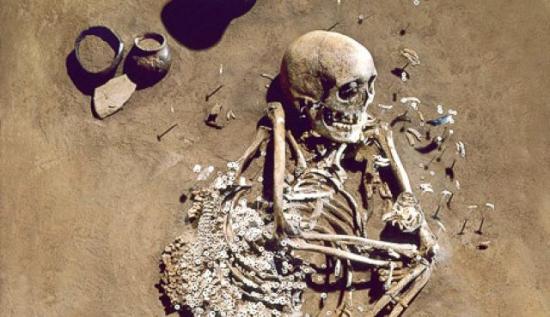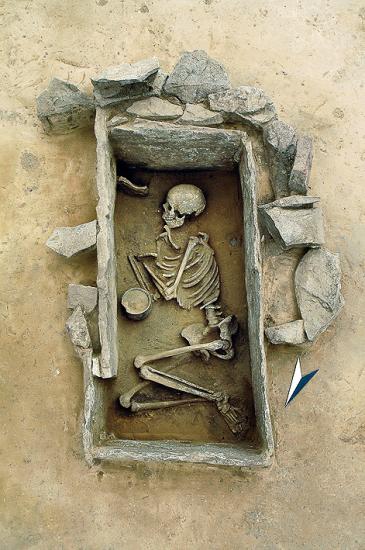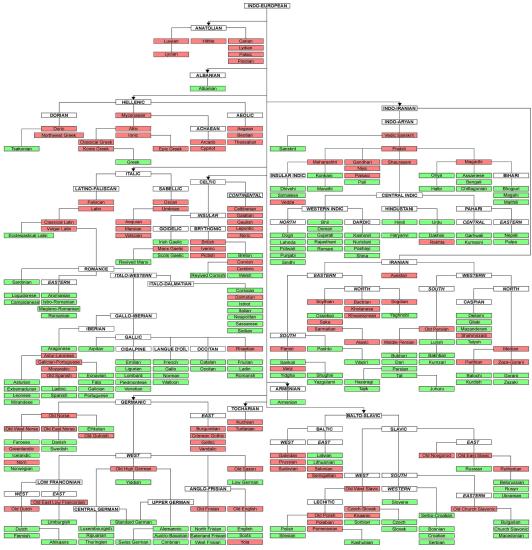DNA from skeletons of Europe's first farmers yielded surprise: There were three, major migrations in prehistoric Europe - one 4,500 years ago from the steppes.
Jack Baldwin Mar
Source - http://www.haaretz.com/life/archaeology/1.645124

Woman and boy buried together, Late Neolithic Corded Ware culture, 4760-4680 BCE, Karsdorf, GermanyPhoto by Juraj Lipták, LDA Sachsen-Anhalt
A study of ancient skeletons as old as 8,000 years reveals a previously unknown, but massive migration of prehistoric people from eastern Russia to Europe and shed light on the spread of the Indo-European mother language in the continent. The study was a collaborative effort between the University of Adelaide and Harvard Medical School in Boston.
Historical linguists have long known that hundreds of languages, ranging from English and Spanish to Russian and Hindi, belong to the same family tree (see below). How that came about has not been clear.
Now the skeletal evidence reveals that at least some Indo-European languages spoken in Europe likely resulted from massive migration from eastern Russia around 4,500 years ago, says Dr Wolfgang Haak of the University of Adelaide's Australian Centre for Ancient DNA (ACAD), the first co-author of the study published today in the journal Nature.
"This new study is the biggest of its kind so far and has helped to improve our understanding of the linguistic impact of Stone Age migration," Dr Haak said.
The first farmers: Not just from Turkey
The team from ACAD used genome-scale data from more than 90 ancient skeletons found around Europe, ranging from 3,000 to 8,000 years old. Based on these genetic studies, the Australian Centre for Ancient DNA was able to trace their origins in partnership with Harvard Medical School.
Beforehand, the thinking had been that all Indo-European languages in Europe owed their origin to the arrival of the first farmers from Anatolia, an area encompassing much of modern-day Turkey, more than 8,000 years ago, says the leader of the study, Professor David Reich of Harvard Medical School.
Now the evidence pointed to two major population replacements in Europe during the Stone Age.
The first was the arrival of Europe's first farmers, spreading from Anatolia. Intriguingly, the genetic profiles of these early European farmers are remarkably similar despite the vast geographic distances between them, says ACAD Director Professor Alan Cooper, co-author on the study. "Whether from Hungary, Germany or Spain, the first farmers are genetically almost identical and must have come from the same origin."
A second component to the gene pool of the agricultural populations of Europe was a resurgence in hunter-gatherer ancestry, around 5000 to 6000 years ago.
The surprise is that, we now realize, there was a third ancestry component: DNA originating from the east appears in every Central European sample after 4,500 years ago.
"We had a bit of an inkling from the mitochondrial studies we did two years ago that were published in Science," says Dr Haak, "but that was only based in mitochondrial data, maternal lineages only, so it's only one side of the story."
"Now when we read the whole story, with additional samples from other geographic locations, with much better resolution using specifically selected SNP markers [an SNP, pronounced 'snip', is a DNA sequence variation commonly occurring in a population], we saw this later input was much, much bigger than we expected, which definitely lends weight to that secondary, more recent migration out of the Russian Steppe," Haak said.
When a corded pottery maker met a cattle herder
The prolific "corded ware" culture from Central Europe, named for their distinctive pottery, owe up to 75% of their ancestry to the "Yamnaya people," cattle herders of the eastern steppe.

Young woman buried in stone cist, Rothenschirmbach site, Late Neolithic Bell Beaker culture, Germany. Photo: LDA Sachsen-Anhalt
"That's enough to tell us that there's definitely a directionality going from east to west and we know where it's coming from. This large migration almost certainly had lasting effects on the languages people spoke," Dr Haak said.
This data lines up well with linguistic research that suggested a more recent spread of Indo-European, due to common words for wheeled-vehicles only being in use since around 5000 years ago.
The researchers' next step will be filling the gaps in migration routes around Europe, and further east where Indo-European languages are spoken.
"Particularly if we want to nail this hypothesis and put a geographical homeland somewhere in the steppes in Ukraine or Southern Russia, then we would assume that whatever was brought by these people would also be found in other populations that today speak an Indo-European language," Dr Haak said. Meaning, he elaborates - that "whatever" could also be found in the populations of Iran or India.

The tree of Indo-European languages